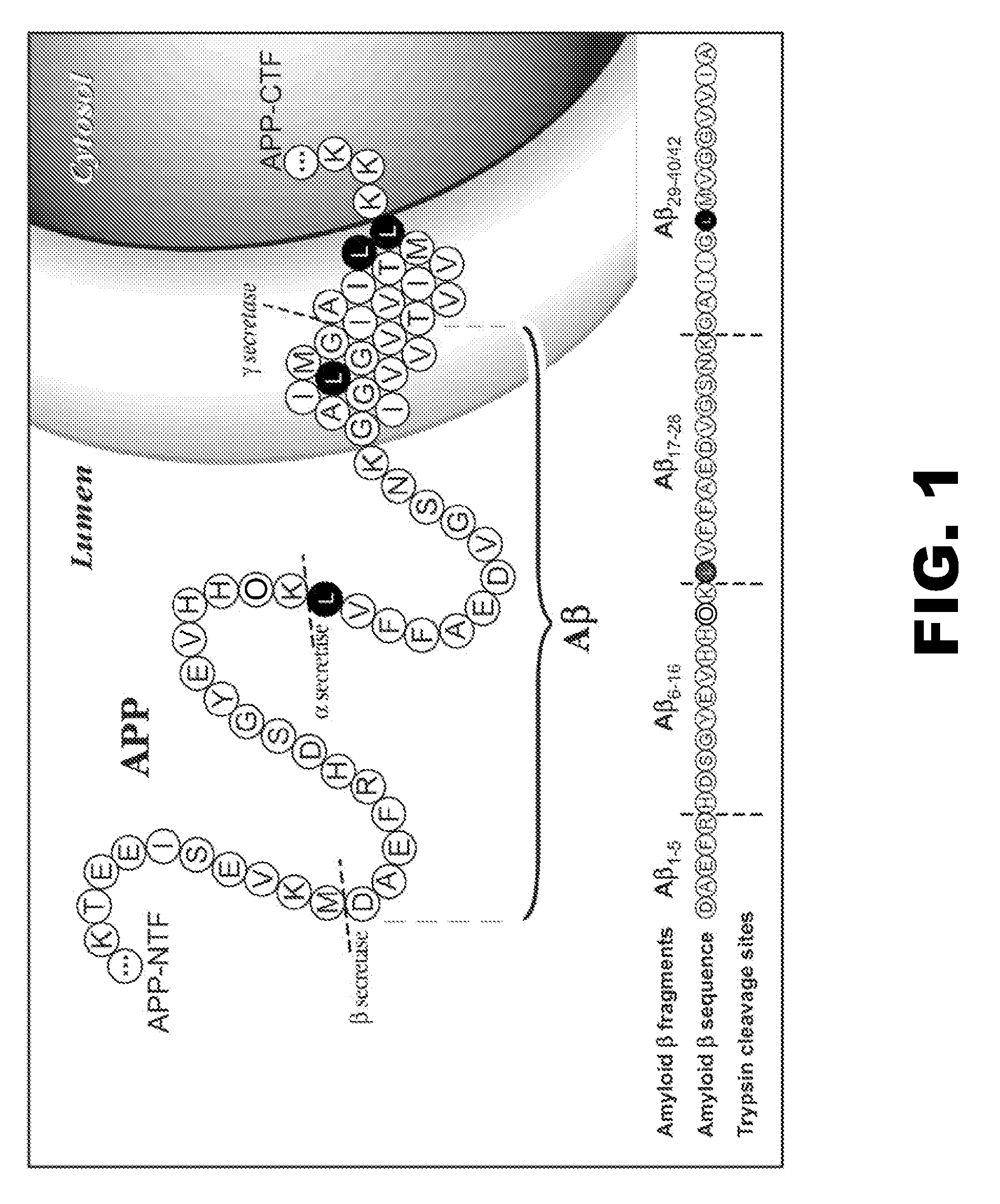Methods for measuring the metabolism of CNS derived biomolecules in vivo
a biomolecule and metabolism technology, applied in the field of methods for diagnosing and treating neurological and neurodegenerative diseases, disorders, etc., can solve the problems of no disease-modifying treatment, increasing public health problems, and taking a heavy personal and financial toll on patients and families
- Summary
- Abstract
- Description
- Claims
- Application Information
AI Technical Summary
Benefits of technology
Problems solved by technology
Method used
Image
Examples
example 1
Measurement of Amyloid-β Metabolism In Vitro
Rationale
[0071]Biochemical, genetic, and animal model evidence implicates Aβ (FIG. 1) as a pathogenic peptide in AD. In order to develop a method to measure Aβ in vivo labeling, an in vitro system was designed using four basic steps: 1) label Aβ in vitro in culture, 2) isolate Aβ from other labeled proteins, 3) specifically cleave Aβ into fragments that could be analyzed for the label, and 4) quantitate the labeled and unlabeled fragments.
Amyloid-β Immunoprecipitation and Cleavage
[0072]First, a method was developed for isolating and measuring unlabeled Aβ from biologic fluids. Aβ was immunoprecipitated from samples of CSF or cell culture media using a highly specific monoclonal antibody (m266), which recognizes the central domain (residues 13-28) of the molecules. Antibody beads were prepared by covalently binding m266 antibody to CNBr Sepharose beads per the manufacturers protocol at a concentration of 10 mg / ml of m266 antibody. The antib...
example 2
Measurement of Amyloid-β Metabolism In Vivo
Rationale
[0080]Protein production and clearance are important parameters that are tightly regulated and reflect normal physiology as well as disease states. Previous studies of protein metabolism in humans have focused on whole body or peripheral body proteins, but not on proteins produced in the central nervous system (CNS). No methods were previously available to quantify protein production or clearance rates in the CNS of humans. Such a method would be valuable to assess not only Aβ production or clearance rates in humans but also the metabolism of a variety other proteins relevant to diseases of the CNS. In order to address critical questions about underlying AD pathogenesis and Aβ metabolism, a method for quantifying Aβ fractional synthesis rate (FSR) and fractional clearance rate (FCR) in vivo in the CNS of humans was developed.
Labeled Leucine Quantitation
[0081]Plasma and CSF samples were analyzed to determine the amount of labeled le...
example 3
Determination of the Effect of ApoE Genotype on CSF Aβ Metabolism
Rationale
[0085]ApoE genotype is a well-validated genetic risk factor for AD. Immunohistochemical studies revealed that ApoE co-localized to extracellular amyloid deposits in AD. Furthermore, ApoE ε4 genotype was found to be a risk factor for AD in human populations. The ApoE ε2 allele has been shown to be protective in the risk of AD. ApoE genotype has also been shown to dramatically effect changes in AD pathology in several mouse models of AD (Holtzman et al. 2000 PNAS 97(2892); Fagan et al. 2002 Neurobiol. Dis 9 (305); Fryer et al. 2005 J Neurosci 25 (2803))
[0086]ApoE ε4 dose dependently increases the density of Aβ deposits in AD and in cerebral amyloid angiopathy (CAA). ApoE is associated with soluble Aβ in CSF, plasma and in normal and AD brain. It is likely that ApoE4 is associated with AD and CAA through the common mechanism of influencing Aβ metabolism, although ApoE4 has been shown to be involved in a variety o...
PUM
| Property | Measurement | Unit |
|---|---|---|
| Force | aaaaa | aaaaa |
| Electrical conductance | aaaaa | aaaaa |
| Electrical conductance | aaaaa | aaaaa |
Abstract
Description
Claims
Application Information
 Login to View More
Login to View More - R&D
- Intellectual Property
- Life Sciences
- Materials
- Tech Scout
- Unparalleled Data Quality
- Higher Quality Content
- 60% Fewer Hallucinations
Browse by: Latest US Patents, China's latest patents, Technical Efficacy Thesaurus, Application Domain, Technology Topic, Popular Technical Reports.
© 2025 PatSnap. All rights reserved.Legal|Privacy policy|Modern Slavery Act Transparency Statement|Sitemap|About US| Contact US: help@patsnap.com



